These cherry and almond scones are a delicious twist on a classic British bake. Soft, buttery, and packed with sweet glacé cherries, they're perfect for afternoon tea, a weekend treat, or a quick homemade bake.
Whether you serve them warm with clotted cream or enjoy them plain, this easy scone recipe delivers bakery-style results at home.
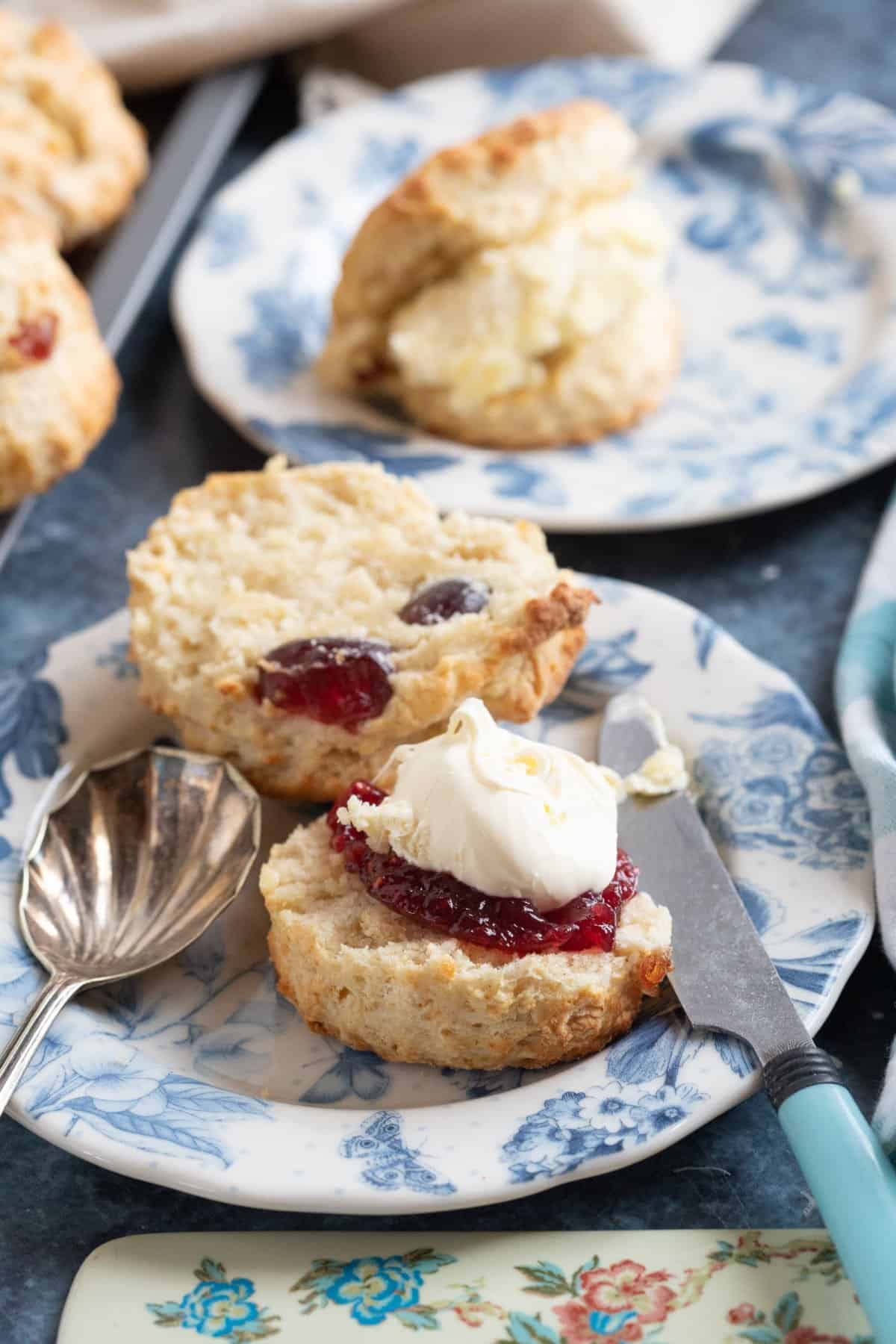
Would you like to save this?
This site is protected by the Google Privacy Policy and Terms of Service apply.
These homemade cherry almond scones are beautifully light and fluffy in texture thanks to the use of buttermilk in the recipe, and a bit more interesting in flavour than traditional plain scones.
👩🍳 Love scones? Try my date and walnut scones too!
Jump to:
✔️ Why you'll love this recipe!
- Easy to make - my 6 year old can make these largely unsupervised, so they are a great recipe for first-time bakers.
- Ready in under 30 minutes.
- Only a handful of ingredients - most of which you will already have in your baking cupboard.
- Adaptable - easily swap the cherries for another fruit.
- Freezer-friendly.
🛒 Ingredients
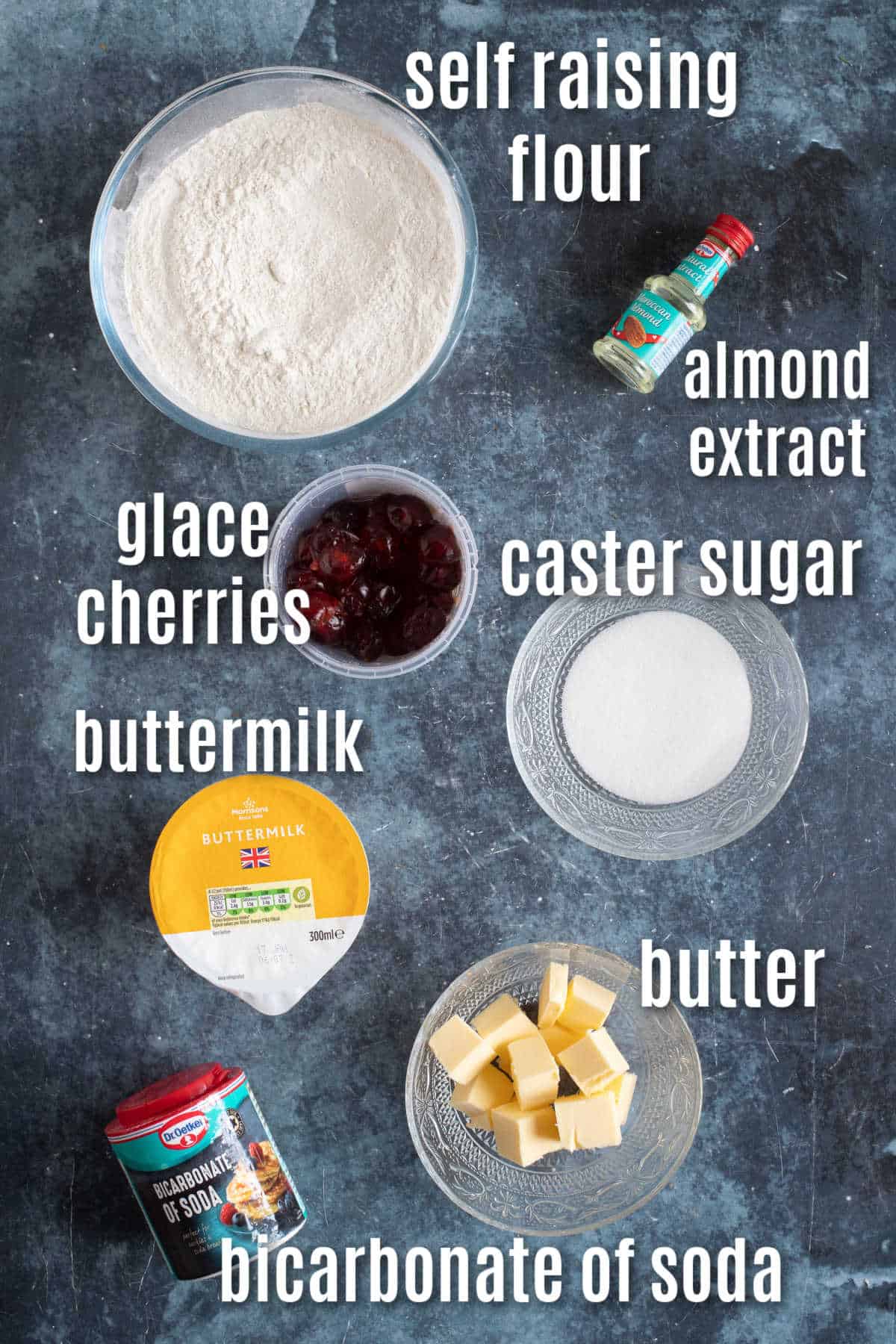
Self-raising flour - I use white self-raising flour, but wholemeal or a 50/50 mix also works well. It already contains a raising agent to help the scones rise.
Bicarbonate of soda - Gives the scones an extra lift and light texture.
Salt - Just a pinch to enhance the flavour.
Caster sugar - Adds sweetness. You can use granulated sugar as a substitute if preferred.
Butter - Use fridge-cold butter, cut into cubes, for the best texture.
Buttermilk - Helps create soft, fluffy scones with a tender crumb.
Glacé cherries - Halved or chopped. You can also use dried or fresh cherries as an alternative.
Almond extract - Adds a subtle, sweet almond flavour that pairs perfectly with the cherries.
Milk - For glazing the tops before baking.
Flaked almonds & demerara sugar (optional) - Sprinkle on top for extra crunch and a golden finish.
🔪 How to make cherry and almond scones
The recipe card with ingredient quantities and detailed instructions can be found at the bottom of the post
One: Sieve the flour into a large mixing bowl and stir in the bicarbonate of soda and salt. Rub the cold cubed butter in with your hands until you get a breadcrumb consistency.
Two: Stir in the sugar with a metal knife.
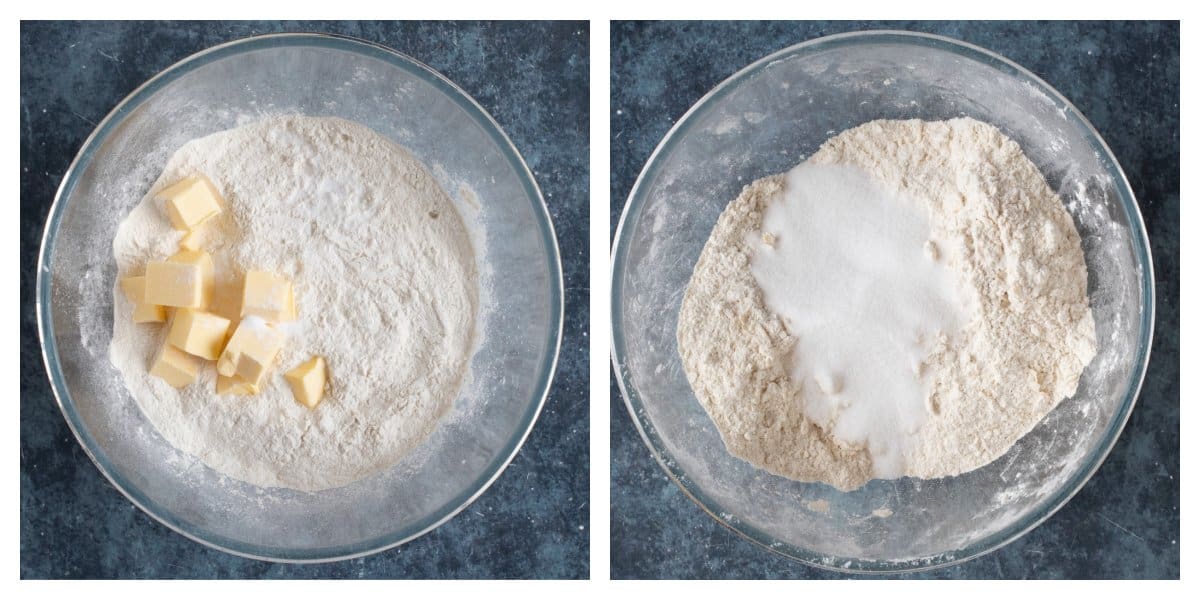
Three: Add the buttermilk to the flour, along with the glace cherries and almond extract. Use the metal knife to mix it in.
Four: Use your hands to form a dough, handling it as little as possible. You don't want the dough to get warm.
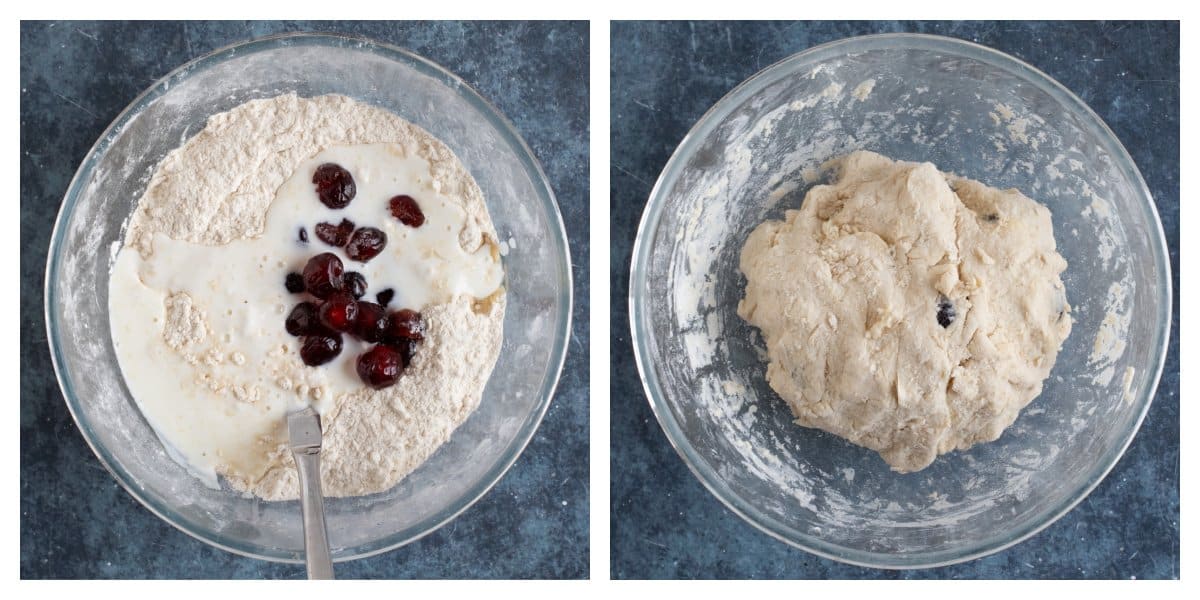
Five: Flour a worktop or wooden board and using your hands (no need for a rolling pin), shape it into a round, about 4cm thick. Use a biscuit cutter to stamp out the scones (try not to twist the cutter otherwise the tops will bake unevenly). Depending on the size of the biscuit cutter, you should get around 8-10 scones from the recipe (I personally find a 5cm cutter works best). You'll need to reform the dough a few times to get the maximum amount of scones from the dough.
Six: Place the scones on a non-stick baking tray (you can line your baking tray if you wish) and glaze the tops with milk, and sprinkle with flaked almonds and demerara sugar, if using. Bake for 12-14 minutes.
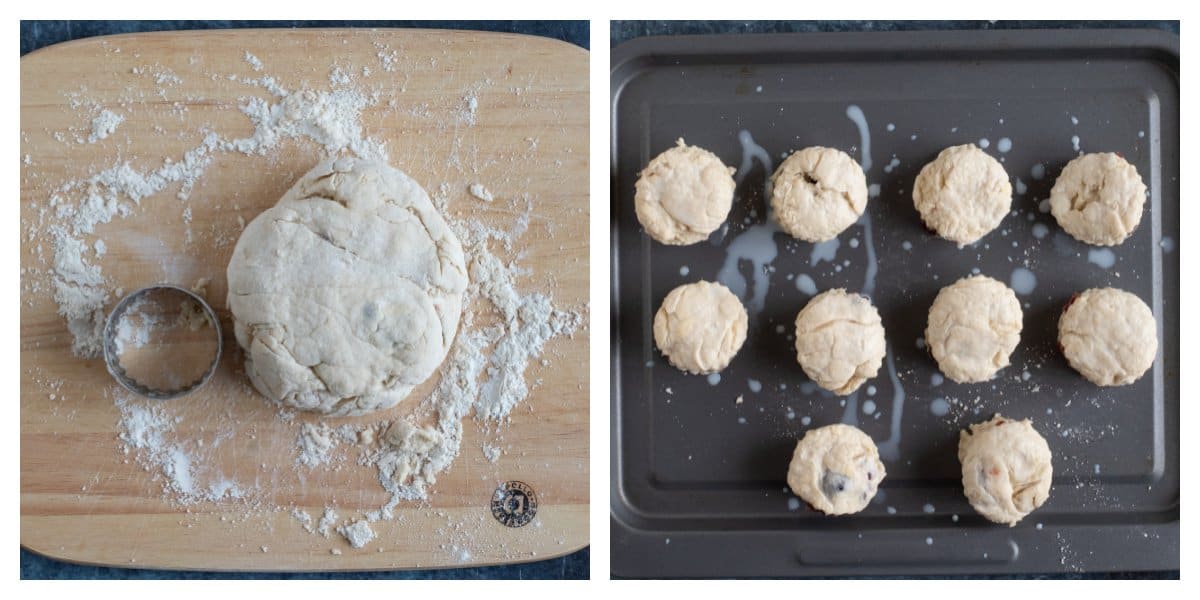
Top Tips
- If you can't find buttermilk, it's easy to make a substitute at home: just add a squeeze of lemon juice to regular milk and let it sit at room temperature for 10-15 minutes. Buttermilk helps create light, fluffy scones by reacting with the raising agents.
- 💡 Pro Tip: Homemade buttermilk tends to be thinner than shop-bought, so you may not need the full amount. Start by adding half, then gradually mix in more until you have a soft, workable dough-avoiding anything too wet or sticky.
- Always use cold, cubed butter straight from the fridge. Soft or warm butter will make the dough greasy and hard to handle. Keeping the butter cold helps create that perfectly flaky scone texture.
- No rolling pin? No problem. Shape the dough gently with your hands for a more rustic, traditional look.
- You can halve the glacé cherries if you prefer smaller pieces, but if you're short on time, leave them whole. I actually enjoy the occasional chunky cherry surprise!
- For sweet scones, use the fluted edge of your cutter for a classic finish.
🍴 Serving suggestions
Serve the cherry and almond scones warm with butter, or for something more indulgent, jam and clotted cream.
If I'm putting together an afternoon tea, I'll usually pop these cherry scones on a cake stand with some mini sausage rolls, cucumber sandwiches, and a few other sweet bits.
📖 Variations
- Use wholemeal self-raising flour or half wholemeal and half white.
- Instead of using glacé cherries, try using dried cherries or fresh pitted cherries. If using fresh cherries you will need to increase the amount of sugar in the recipe to 100g.
- Swap the cherries for currants and make my easy fruit scones.
- Make traditional Victoria scones, which has an egg in the recipe for richness!
- Sprinkle the tops of the scones with demerara sugar and flaked almonds before baking, for an extra special crunchy topping.
- Add in 50g of dark chocolate chips for cherry and chocolate scones.
- Don't like almond? Swap with vanilla extract instead and make cherry and vanilla scones.
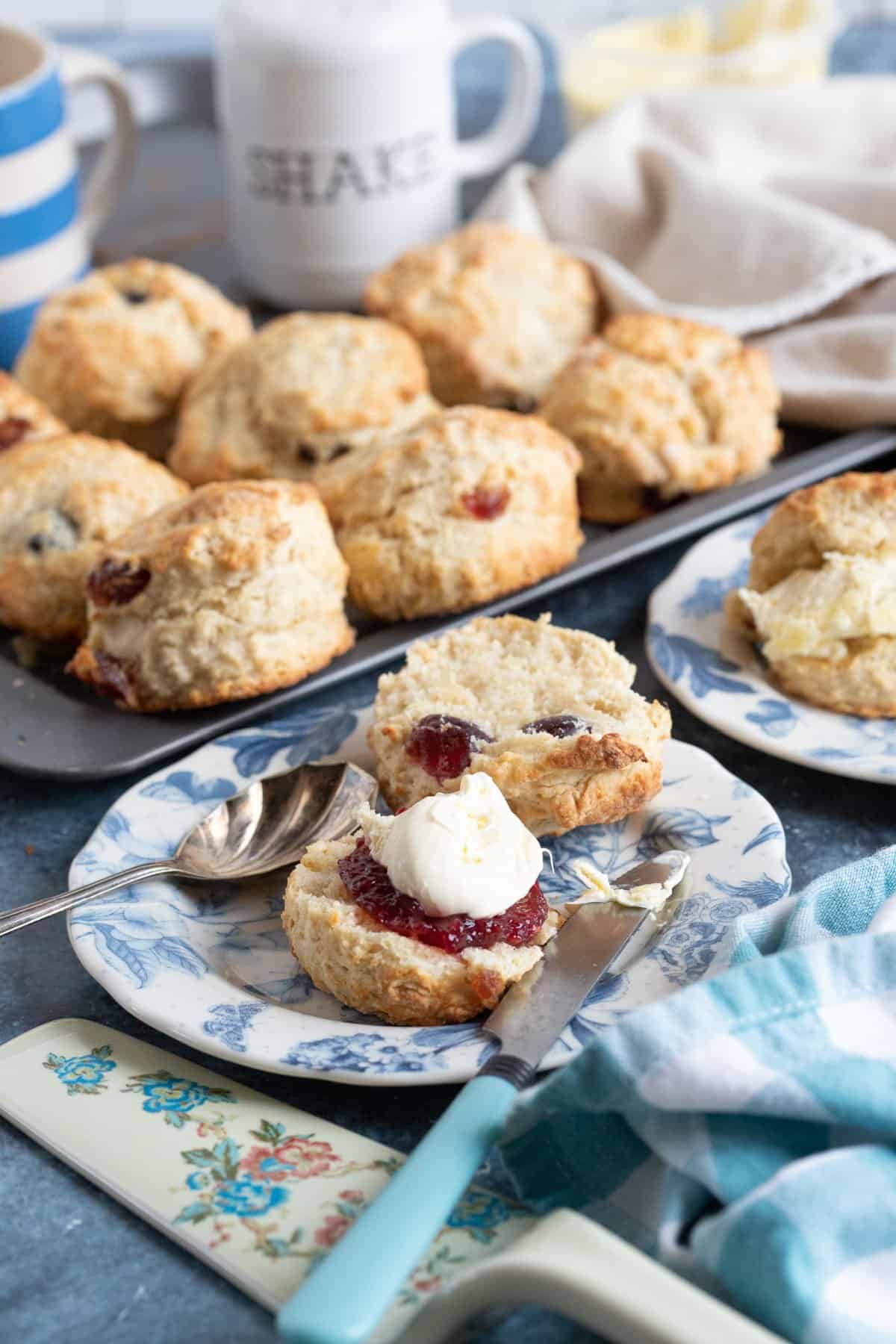
British scones vs American scones
In Britain, scones are traditionally cut into rounds using a plain or fluted-edged cutter. They're usually plain or contain dried fruit, with the tops brushed in milk or egg for a golden finish. Once baked, they're typically split in half and served with jam first, then clotted cream-or just a simple smear of butter. Cheese scones are also popular and made using the same method, just without the sugar.
In America, scones tend to look a little different. They're often cut into triangular wedges and are generally sweeter than their British counterparts, with more sugar in the dough and a glaze or sugary topping added after baking.
🥡 Storage
Scones are at their best fresh from the oven, still warm and soft.
Store - Keep scones in an airtight container at room temperature for up to 3 days.
Reheat - Sprinkle lightly with water and warm in a hot oven for a few minutes to refresh them-this helps bring back that just-baked texture.
Freeze - Scones freeze brilliantly. Once completely cool, place them in a freezer-safe container or bag and freeze for up to 3 months. Defrost at room temperature, then reheat in the oven or microwave if desired.
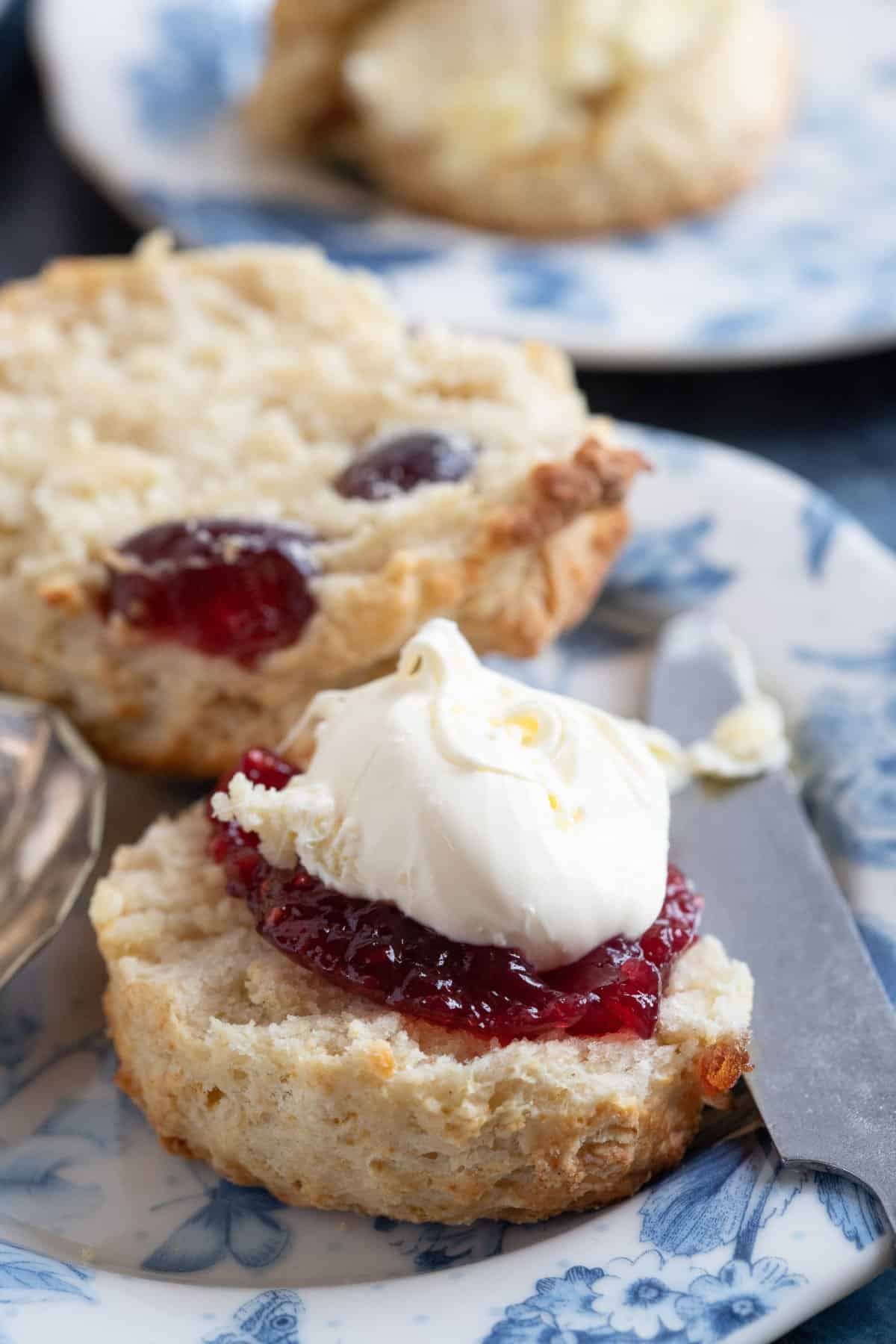
❓ FAQs
The tops of the scones should be a rich golden brown colour, and when you pick the scone up and tap the bottom, it should sound hollow.
Traditional buttermilk is a thin, cloudy, slightly tart but buttery-tasting liquid that's the by-product after cream is churned to make butter. These days it is more commonly sold as a thick liquid (usually next to the cream in the supermarket), produced commercially by adding an acidifying bacteria to milk.
Using fridge-cold butter produces the flakiest, lightest scones. If the dough is allowed to get too warm (by using room temperature butter and also handling the dough too much), your scones will turn out dense and heavy. What you are looking for is a light, fluffy and flaky texture when you break one in half.
Plain flour can be used in place of self-raising flour, but you will need to add baking powder to ensure the scones rise. Add 2 teaspoons of baking powder to every 150g of plain flour for homemade self-raising flour.
😋 More scone recipes
Recipe
Cherry and Almond Scones
Would you like to save this?
This site is protected by the Google Privacy Policy and Terms of Service apply.
Ingredients
- 450 g Self Raising Flour
- 1 teaspoon Bicarbonate of Soda
- ½ teaspoon Salt
- 100 g Butter cubed and fridge cold
- 50 g Caster Sugar
- 300 ml Buttermilk
- 1 teaspoon Almond Extract
- 120 g Glacé Cherries
- 3 tablespoon Milk for glazing
Optional
- 2 tablespoon Demerara Sugar
- 2 tablespoon Flaked Almonds
Instructions
- Preheat the oven to 220°c (200 fan/ Gas 7) and line a baking tray with baking paper.
- Sieve the flour into a large mixing bowl and stir in the bicarbonate of soda and salt450 g Self Raising Flour, 1 teaspoon Bicarbonate of Soda, ½ teaspoon Salt
- Rub the cold cubed butter in with your hands until you get a breadcrumb consistency.100 g Butter
- Stir in the sugar with a metal knife.50 g Caster Sugar
- Add the buttermilk to the flour, along with the glace cherries and almond extract. Use the metal knife to mix it in.300 ml Buttermilk, 1 teaspoon Almond Extract, 120 g Glacé Cherries
- Use your hands to form a dough, handling it as little as possible. You don't want the dough to get warm.
- Flour a worktop or wooden board and using your hands (no need for a rolling pin), shape it into a round, about 4cm thick. Use a biscuit cutter to stamp out the scones (try not to twist the cutter otherwise the tops will bake unevenly). Depending on the size of the biscuit cutter, you should get around 8-10 scones from the recipe (I personally find a 5cm cutter works best). You'll need to reform the dough a few times to get the maximum amount of scones from the dough.
- Place the scones on a non-stick baking tray (you can line your baking tray if you wish) and glaze the tops with milk, and sprinkle with flaked almonds and demerara sugar, if using. Bake for 12-14 minutes.3 tablespoon Milk, 2 tablespoon Demerara Sugar, 2 tablespoon Flaked Almonds
Notes
Don't forget to subscribe to the newsletter to stay up to date with what's cooking in the Effortless Foodie kitchen! You can also follow me on Facebook, Twitter, and Instagram too!


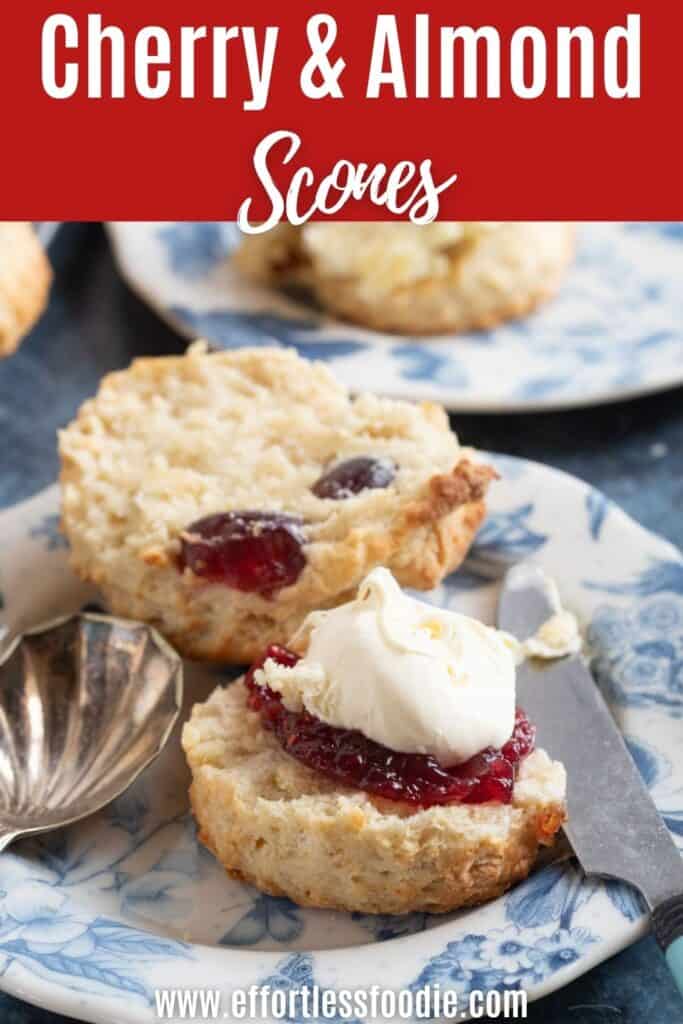
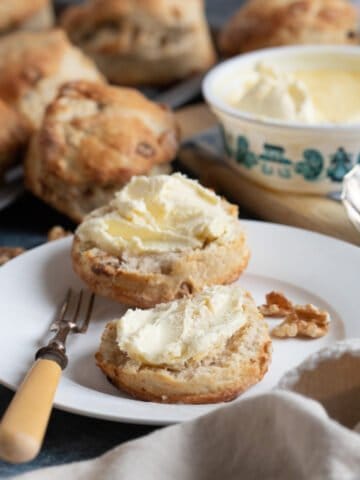

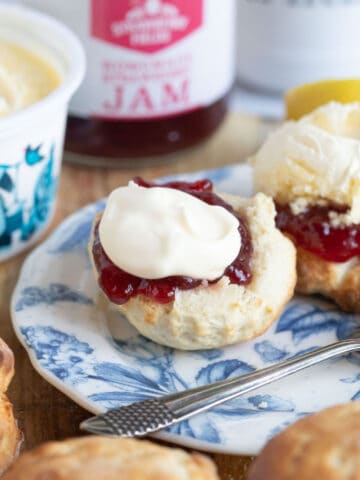
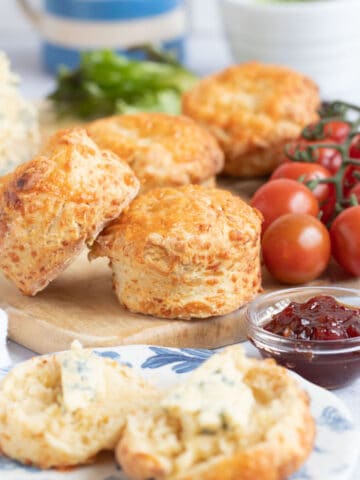

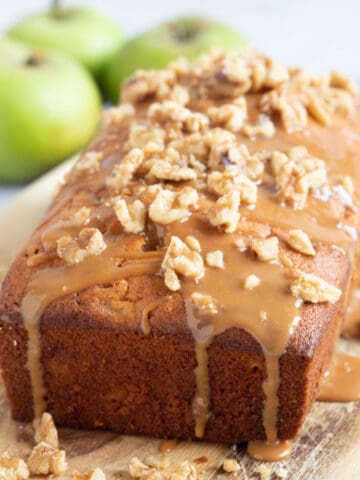
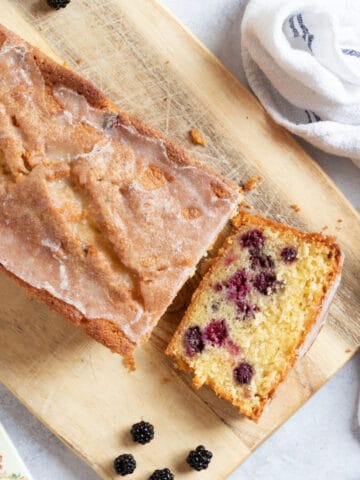
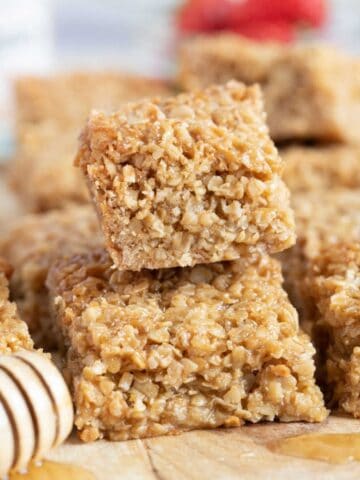
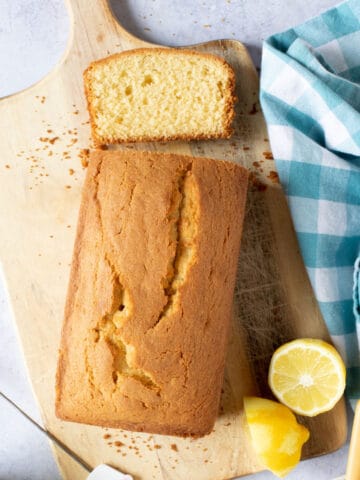
Gina
I love a good scone, but cherry almond makes me love it even more! Such a great recipe! This is how l like to start my morning this scone and a cup of tea or coffee!
Savita
These scones look so fluffy and light, the perfect treat!
Tavo
I can't wait to make these scones! I am a big fan of cherries and almonds! Together in a scone... marvelous!
Qashang
Had them for breakfast and they were a winner!
Liz
I'd been making savory scones but I wanted to try my hand at sweet ones and these were great! I love cherries in any form so this is perfect.